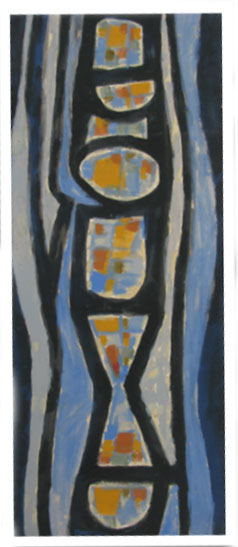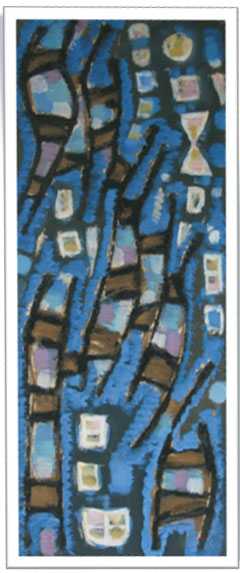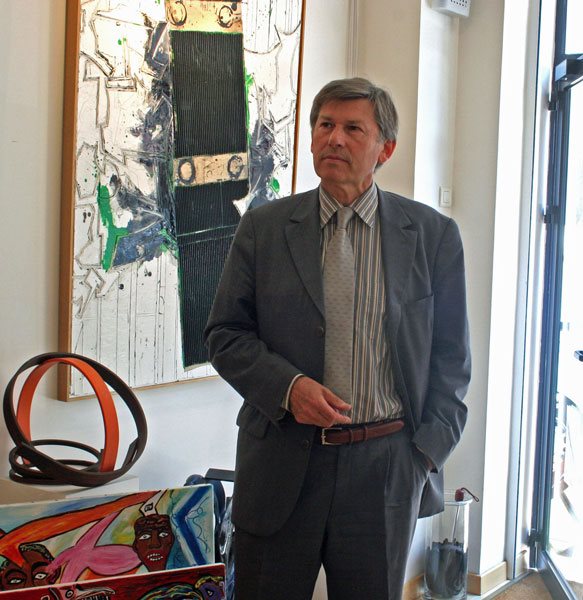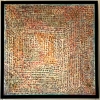A l’occasion du centenaire d’Alfred Manessier (1911-1993),
la galerie Antoine Laurentin présentera dans la section Tefaf Paper à Maastricht puis à la galerie Antoine Laurentin, un ensemble inédit d’œuvres retraçant le parcours de ce grand artiste abstrait.
Galerie Antoine LAURENTIN
23 quai Voltaire
75007 Paris
Tel : 01.42.97.43.42
e-mail : contact[at]galerie-laurentin.com
site : www.galerie-laurentin.com
En effet, il y a de nombreuses années qu’un ensemble aussi cohérent de ses gouaches, aquarelles et huiles sur papier n’a été proposé sur le marché et montré en dehors d’expositions muséales alors qu’Alfred Manessier, peintre français, fut, dans les années 1950-1960, l´un des représentants majeurs de l’Ecole de Paris.
| L’occasion du centenaire de sa naissance, va permettre de (re)découvrir cette figure de premier plan de la création du XXe siècle, et de voir combien l’abstraction, mouvement de portée internationale, né en France est un art plein de sens qui peut contribuer à réenchanter le monde par un festival de couleurs et de formes. Manessier et ses amis artistes de la seconde Ecole de Paris ont toujours voulu, à travers le difficile combat qu’est l’abstraction, associer l’homme au monde qui l’entoure afin qu’il prenne conscience de sa condition dans l’univers. En effet l’œuvre de Manessier est une quête perpétuelle du dépassement, il essaye de faire naître dans l’esprit de celui qui regarde son œuvre un sentiment d’absolu qui, peut-être, le conduira comme lui à une découverte d’un sentiment de spiritualité. L’œuvre de Manessier, qui peut nous sembler complexe dans sa grande variété d’inspiration, trouve son unité dans sa vision du monde où le sacré et le profane s’harmonisent. « J’ai profondément ressenti le lien cosmique entre ce chant sacré [celui des moines] et cette nature tout autour (…). Je sentais, à les entendre, combien notre monde laïque a besoin de retrouver le sens du sacré ». |
 |
|
Alfred MANESSIER (Saint-Ouen 1911 - Orléans 1993) Offrande |
|
For the centenary of Alfred Manessier (1911-1993), It is many years since such a consistent collection of Alfred Manessier's gouaches, watercolours and oils on paper have been offered on the market and exhibited outside a museum, although this French painter was one of the leading exponents of the Second Paris School in the Fifties and Sixties. |
 |
|
Alfred MANESSIER (Saint-Ouen 1911 - Orléans 1993) |
BIOGRAPHIE D’ALFRED MANESSIER |
| Fils unique d’une famille d’artisans, Alfred Manessier voit son enfance troublée par l’envoi de son père au Front, en 1914. Sa famille part régulièrement en vacances dans la baie de Somme, au Crotoy, où l’artiste peint à l’âge de douze ans ses premières aquarelles. En 1924, Manessier étudie à l’École des beaux-arts d’Amiens où il prépare le concours d’entrée à l’École nationale des beaux-arts de Paris. En 1927, Manessier découvre Picasso et Rembrandt qu’il considère toute sa vie comme son père spirituel et son modèle de vie en peinture. Il est reçu en section peinture à l’École nationale des beaux-arts de Paris en 1929-1930, mais intégrera selon les souhaits de son père la section architecture. En 1931, il effectue un voyage d’études en Hollande, à Hilversum, où il rencontre l’architecte Willem Marinus Dudok, ami de Mondrian. Il participe pour la première fois au Salon des Indépendants en 1933 et fréquente certaines académies libres de Montparnasse. Jusqu’à la guerre, il se montre sensible aux idées cubistes, puis surréalistes. L’année suivante, il habite un atelier parisien, voisin de celui d’André Masson et côtoie Robert Delaunay. À la mort de son père et de son grand père en 1936, il doit renoncer à ses études et à la peinture pour aider sa mère à maintenir l’entreprise familiale, jusqu’à la liquidation du stock en 1937. En 1938, il emménage dans un atelier à Paris avec sa mère, et peut se consacrer à la peinture. Il se marie la même année, avec Thérèse Simonnet et s’installe près de chez Gustave Singier et de Brancusi. Il est mobilisé en 1939, démobilisé en 1940, et réfugié dans le Lot. Alors qu’il se dirige vers l’abstraction, il est l’un des fondateurs du Salon de Mai et participe en 1945 à la première édition. Au début de l’année 1944, l’artiste reçoit la visite de René Drouin et Gildo Caputo, futur directeur de la Galerie de France. La Galerie René Drouin lui propose un contrat qui se prolonge jusqu’en 1948. Le Musée National d’Art Moderne de Paris achète sa première œuvre de Manessier en 1944. Il participe à l’Exposition de la « Jeune peinture française », au Palais des Beaux-Arts de Bruxelles, et réalise ses premières ventes à des amateurs étrangers. Au printemps 1947, il reçoit la visite de Georges Rouault, qui fait le lien entre les œuvres présentées dans l’atelier et des vitraux. Il reçoit une commande pour les vitraux d’une petite église de campagne, Sainte-Agathe des Bréseux, qui sont inaugurés en 1950. Ses premières expositions personnelles sont organisées en 1949 à la Galerie Jeanne Bucher. Sa première exposition personnelle à l’étranger a lieu à la Galerie Apollo à Bruxelles en décembre 1951. À partir de 1953, il expose régulièrement à la Galerie de France, jusqu’à sa mort. En 1953 et 1955 deux prix internationaux consacrent son œuvre : le premier prix de Peinture à la Biennale de São Paulo et le grand prix de Peinture à l’Institut Carnegie de Pittsburgh. Les événements de Hongrie provoquent la fin d’une période de peinture lumineuse et joyeuse inspirée par la Hollande. Deux séjours en Haute-Provence, en 1958 et 1959 marquent un tournant décisif dans son œuvre. Il exécute sur place une série de lavis sur les rythmes de la nature, puis de retour à l’atelier, une série de tableaux qui seront présentés à la Galerie de France fin 1959. Le grand prix de Peinture lui est attribué à la XXXIe Biennale de Venise en 1962. En 1964 a lieu une exposition personnelle itinérante aux Etats-Unis et il peint un « Hommage à Martin Luther King », en avril 1968. Il traverse ensuite une période troublée par l’expulsion de son atelier parisien, dans lequel il vient de réaliser une importante série d’aquarelles. Cet atelier est détruit en 1973, année pendant laquelle la Fondation Gulbenkian à Lisbonne lui consacre une rétrospective. De mai à juin 1977 il séjourne au Crotoy, et la série des « Sables » naît de ce retour sur les lieux de son enfance. Alfred Manessier amorce à cette époque deux nouvelles séries de peinture qu’il poursuit jusqu’en 1985. La première évoque les paysages aquatiques liés à sa prime enfance à Thuison, la seconde des bidonvilles imaginés du Brésil. Victime d’un accident de voiture à son retour de vacances, il décède le dimanche 1er août 1993. |
BIOGRAPHY of ALFRED MANESSIER |
|
Only son of an artisan family, Alfred Manessier is affected during his childhood by his father’s involvement to the war in 1914. His family regularly goes on holidays in the Somme Bay, to Crotoy, where the artist paints at the age of twelve his first watercolors. Since 1924, Manessier studies at the School of Fine Arts of Amiens where he prepares the entrance examination to the national School of Fine Arts of Paris. In 1927, Manessier discovers Picasso and Rembrandt that he considers his entire life as his spiritual father and his model of life in painting. He is received in painting section at the national School of Fine Arts of Paris for the school year 1929-1930, but he only enters it one year later, in architecture section, according to the will of his father. In 1931, he meets the architect Willem Marinus Dudok, a friend of Mondrian during a study trip in Holland, to Hilversum. |
PRESENTATION OF THE GALLERY: |
|
Issu d'une famille de collectionneurs, Antoine Laurentin appartenait au monde des amateurs bien avant de transformer sa passion en métier. Spécialisé dans les dessins, peintures et sculptures de la fin du XIXème siècle au milieu du XXème siècle, soit des Nabis aux abstraits des années 50, il ouvre en 1991 une galerie rue Sainte-Anne puis s'installe en 2004 au 23 quai Voltaire soit en plein cœur. Antoine Laurentin comes from a family of collectors and was a collector himself long before turning his passion into the art dealing business. He opened his gallery in 1991 rue Sainte-Anne, before opening 23 Quai Voltaire, and is specialised in the end of the Nineteenth century and the Twentieth century, with works ranging from the Nabis to the Abstracts. |
DATES DE L’EXPOSITION : |
|
- TEFAF, MAASTRICHT, STAND N°709, 16 AU 25 MARS |
INFORMATIONS PRATIQUES – INFOS : |
|
Galerie ANTOINE LAURENTIN |
HORAIRES ET ACCES : |
|
La galerie est ouverte du lundi au vendredi de 10h30 à 13h et de 14h à 19h, le samedi de 14h à 18h. Antoine Laurentin - Caroline Jouquey Graziani |

















